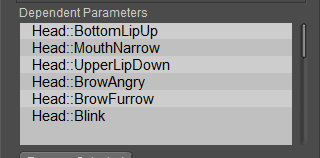Keyed Dependencies
The Keyed Dependencies tab in Dependent Parameters window displays the following settings and options:

Keyed Dependencies tab.
- Master Parameter (1): Lists the name of the Master Parameter dial that will control the other parameters listed in the Dependent Parameters list.
- New Master (2): Click this button to create a new Master Parameter dial. After you enter a name, the Dependent Parameters window will immediately switch to that master parameter so that you can assign which parameters are driven by the master dial.
- Start Teaching (3): Click this button to “record” the changes that you want to link to the currently selected dial and value.
- Value slider and number (4): Drag the slider left or right to increase or decrease the value. You can also click the value field and enter a number.
- Dependent Parameters (5): Provides a list of the other parameters in the figure that will be affected when you adjust the Master Parameter dial. For example, when you dial the Bend morph to -90 you want a change to occur in the Left Shoulder body part.
- Remove Selected (6): To remove dependent parameters, click to highlight one or more of the entries in the Dependent Parameters list, then click the Remove Selected button.
- Type (7): There are two types of Master Parameter:
- Keyed: This master parameter type is the only type of dial that you can create in the Dependent Parameter palette. You can create linear links or curved links that have varying driven values at any value of the master parameter.
- Delta Add: If you see this type listed, it means that the relationship between the master parameter dial and its dependent parameters were created externally (most often by content developers that created the relationships while editing the figure’s CR2 character file). A Delta Add type is also created when you use the Morphing Tool across body parts. Delta Add parameters are editable in the Dependent Parameters editor. When you add additional keys to a Delta master parameter, it remains a Delta master parameter.
- Graph (8): The graph displays how the selected driven parameter behaves when travelling from one end of the dial to the next. See The Dependent Parameter Editor Graph.
- Prev Key (9) and Next Key (10) buttons: Allows you to move through keys set through the lower and upper range of the master parameter dial. For a more detailed description, see Creating Master Parameters.
When you look at the Angry parameter in Roxie’s head, you’ll notice that there are a number of facial expression morphs linked to the master parameter dial. These are linked to the master parameter dial as described in Creating Master Parameters.

Keyed dependent parameters.